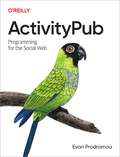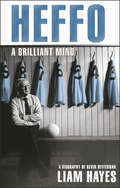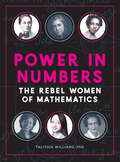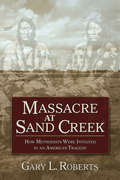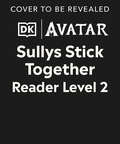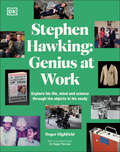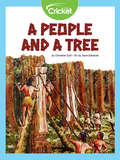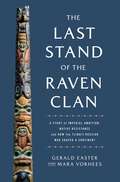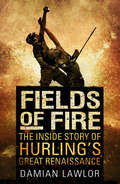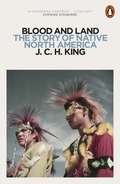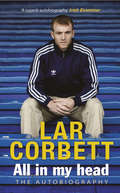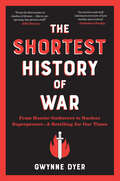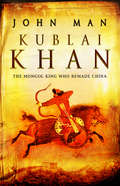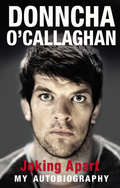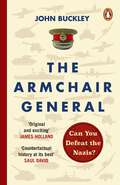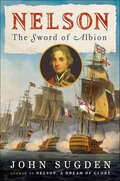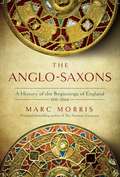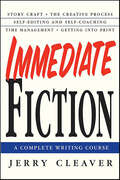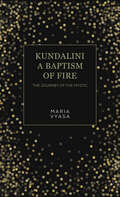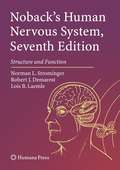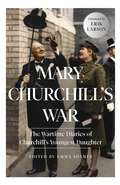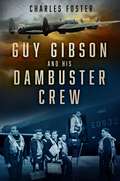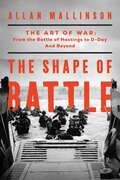- Table View
- List View
ActivityPub: Programming for the Social Web
by Evan ProdromouActivityPub is the new standard for connecting social networks together on the social web. This open, decentralized social networking protocol defines an API for sharing activities to a social network and a procedure that servers use to distribute those activities to a subscriber's feed. With this book, you'll learn how to assemble ActivityPub-enabled clients for making new kinds of social apps on top of existing networks and build ActivityPub servers that create new human or automated accounts on the social web.With those skills under your belt, you can explore other applications of this publish-subscribe technology: content management systems, internet of things, and enterprise automation. With hands-on examples and in-depth knowledge from Evan Prodromou, one of the authors of the protocol, this is the ActivityPub handbook that every social software hacker needs.Learn what the social web is and what ActivityPub doesRepresent social network data in the Activity Streams 2.0 formatWrite a simple ActivityPub client and serverExtend ActivityPub's functionality with new typesFind in-depth details about the more obscure ActivityPub data structuresEvan Prodromou is a coauthor of the ActivityPub protocol and the Activity Streams 2.0 data format.
Heffo - A Brilliant Mind: A Biography of Kevin Heffernan
by Liam HayesKevin Heffernan was a giant amongst GAA men. A giant with a brilliant mind who repeatedly warned everybody that he would not let his own mother get in the way of him winning one more game of football. Heffo was deeply admired and absolutely feared like no other. And like no other manager in the history of the GAA, his strength of mind and brutal toughness as a leader raised an army that was called his own – Heffo’s Army. Heffo: A Brilliant Mind tells the Kevin Heffernan story for the first time. It’s the story of a boy with the biggest dreams, and a man who lived with triumphs and the greatest regrets. It’s the story of a club, and how Heffo and St Vincent’s GAA club revolutionized the game of Gaelic football and changed the face of Dublin football forever. It’s the story, too, of a great war. Heffo: A Brilliant Mind dramatically re-enacts the battles that Kevin Heffernan fought over four decades as a footballer and a manager in a long and punishing war with Kerry. A war waged by one man with the courage and fearlessness of a true giant.
Power in Numbers: The Rebel Women of Mathematics
by Talithia WilliamsFrom rocket scientists to code breakers, “fascinating stories” of women who overcame obstacles, shattered stereotypes, and pursued their passion for math (Notices of the American Mathematical Society).With more than 200 photos and original interviews with several of the amazing women covered, Power in Numbers: The Rebel Women of Mathematics is a full-color volume that puts a spotlight on the influence of women on the development of mathematics over the last two millennia. Each biography reveals the life of a different female mathematician, from her childhood and early influences to the challenges she faced and the great achievements she made in spite of them. Learn how:After her father terminated her math lessons, Sofia Kovalevskaya snuck algebra books into her bed to read at nightEmmy Noether became an invaluable resource to Albert Einstein while she was in the NavyNative American rocket scientist Mary Golda Ross developed designs for fighter jets and missiles in a top-secret unitKatherine Johnson’s life-or-death calculations at NASA meant that astronauts such as Alan Shepard and John Glenn made it home aliveShakuntala Devi multiplied massive numbers in her head so her family could eat at nightPamela Harris proved her school counselors wrong when they told her she would only succeed as a bilinguial secretaryCarla Cotwright-Williams began her life in the dangerous streets of South-Central Los Angeles before skyrocketing to a powerful career with the Department of Defense in Washington, DCThese women are a diverse group, but their stories have one thing in common: At some point on their journeys, someone believed in them—and made them think the impossible was perhaps not so impossible.“A quick read . . . full of dramatic stories and eye-catching illustrations.” —MAA Reviews“I found myself marveling at the personal anecdotes and quotes throughout the book.” —Notices of the American Mathematical Society
Massacre at Sand Creek: How Methodists Were Involved in an American Tragedy
by Gary L. RobertsSand Creek.At dawn on the morning of November 29, 1864, Colonel John Milton Chivington gave the command that led to slaughter of 230 peaceful Cheyennes and Arapahos—primarily women, children, and elderly—camped under the protection of the U. S. government along Sand Creek in Colorado Territory and flying both an American flag and a white flag. The Sand Creek massacre seized national attention in the winter of 1864-1865 and generated a controversy that still excites heated debate more than 150 years later. At Sand Creek demoniac forces seemed unloosed so completely that humanity itself was the casualty. That was the charge that drew public attention to the Colorado frontier in 1865. That was the claim that spawned heated debate in Congress, two congressional hearings, and a military commission. Westerners vociferously and passionately denied the accusations. Reformers seized the charges as evidence of the failure of American Indian policy. Sand Creek launched a war that was not truly over for fifteen years. In the first year alone, it cost the United States government $50,000,000.Methodists have a special stake in this story. The governor whose polices led the Cheyennes and Arapahos to Sand Creek was a prominent Methodist layman. Colonel Chivington was a Methodist minister. Perhaps those were merely coincidences, but the question also remains of how the Methodist Episcopal Church itself responded to the massacre. Was it also somehow culpable in what happened?It is time for this story to be told. Coming to grips with what happened at Sand Creek involves hard questions and unsatisfactory answers not only about what happened but also about what led to it and why. It stirs ancient questions about the best and worst in every person, questions older than history, questions as relevant as today’s headlines, questions we all must answer from within.
DK Super Readers Level 2 Avatar Sullys Stick Together (DK Super Readers)
by DKBoost your reading skills and meet the family at the heart of James Cameron’s Avatar!If Jake Sully, Neytiri, and their children know one thing it’s that wherever they go, family is their fortress. With this reader, young bookworms can learn all about the Sullys, the Na’vi and their planet Pandora. They’ll discover the incredible creatures that can be found across the land, sea, and in the skies, and meet all the Sullys’ friends along the way. Packed with amazing imagery, clear and simple vocabulary, and a fun quiz, this thrilling Level 2 DK Reader will help 5-7-year-olds Avatar fans build their reading abilities and confidence while taking an epic voyage across Pandora.
Stephen Hawking Genius at Work
by Roger HighfieldA behind-the-scenes tour of the inner sanctum of one of the world's most prominent scientific thinkers.In 2021, The Science Museum made a once-in-a-lifetime acquisition of the contents of Stephen Hawking's office. This book delves into that remarkable collection, using the seminal papers, items, and curiosities in his office to explain his theories and reveal more about one of the greatest minds in modern science. It's an unprecedented glimpse into the life of the best-known scientist of modern times. - Artifacts include:- A Simpsons bomber jacket gifted to him following his appearance on the show- A copy of Hawking's PhD thesis: Properties of an Expanding Universe- Singularities and the Geometry of Space, written at the beginning of his vital collaboration with Roger Penrose- His blackboard, where he debated ideas and doodled with his contemporaries- Scientific bets made with colleagues to prove (and sometimes disprove) his theories- His Permobil F3 wheelchair and communications systems- Hawking's Franklin medal and his CBE
A People and a Tree
by Christine GrafNative American tribes from the Northwest Coast learned to use the wood of cedar trees for many of their daily needs. Tribes used recycling to conserve resources hundreds of years ago. Pounding bark until it was fluffy to make diapers and with special thin branches called withes, cedar trees were soaked and used to make rope. What special technique did tribes use to take down big cedar trees?
The Last Stand of the Raven Clan: A Story of Imperial Ambition, Native Resistance and How the Tlingit-Russian War Shaped a Continent
by Gerald Easter Mara VorheesA dynamic history of the Battle of Sitka that recognizes the vital importance of the Tlingit people, their fight against Imperial Russia, and how it changed the fate of the North America.&“If the long-term plans of Peter the Great had been realized, then California never would have become a Spanish colony,&” asserted the head of the Russian-American Company. At the turn of the nineteenth century, Russia was a rising power in North America. The Tsar&’s empire extended across the Bering Sea, through the Aleutians and Kodiak Island, and down the Alaskan panhandle. The objective of this imperialist project was to corner the lucrative North Pacific fur trade and colonize the American coastline all the way to San Francisco Bay. The audacious scheme was moving apace until the Russians were finally confronted and stalled on the battlefield. When Russia went to war in America, the fate of a continent was at stake. Yet it was neither the Old-World rivals Spain and Britain nor the upstart United States who stopped Russian expansion, but a coalition of defiant Tlingit tribes. The Last Stand of the Raven Clan is the true story of how the indigenous Tlingit people of southeast Alaska thwarted Imperial Russia&’s grand plan of conquest in North America. Leading the charge was the young war chief K'alyáan, a hero as fierce and courageous as Crazy Horse or Geronimo. The Tlingit stance against Russian colonization—during the Battle of Sitka and beyond—was arguably the most successful indigenous resistance against European imperialism in North America. Tlingit oral histories and Russian eyewitness accounts bring this history to life, shedding light on events both inspiring and infamous: the Massacre at Refuge Rock, one of Native America&’s worst atrocities; the Survival March, the perilous Tlingit retreat to avoid Russian capture and enslavement; and the cutthroat competition between the U.S. and Russia to control the northern Pacific. Ultimately, The Last Stand of the Raven Clan chronicles the determined struggle for survival of the Tlingit people in their ancestral homeland and places the Battle of Sitka in its rightful spot as a key turning point in North American history.
Fields of Fire: The Inside Story of Hurling's Great Renaissance
by Damian LawlorThese are exceptional times for the game of hurling. The skill, speed and summer long edge of the seat drama of recent All Ireland championships has led many to conclude that something very special is happening in the ancient game.The Kilkenny team of the last decade has undoubtedly been the greatest in the history of hurling. Their extraordinary record speaks for itself. But has a chink finally begun to appear in Kilkenny’s armour? Or is it that the challengers have begun to catch up, at last recognising the immense effort required to compete at the highest level?Fields Of Fire tells the story of Kilkenny’s phenomenal success and explores how the Cats became an almost indomitable force. But it also looks at the profound challenge which their supremacy presented to other counties, revealing how the struggle for competitiveness has positively transformed the game. Old rivals have adapted and learned. But new powers too have emerged – from Clare and from Limerick, from Dublin and from Waterford - young bloods who do not fear the Kings of the Game.Drawing on exclusive interviews with dozens of current and former legends, among them Eddie Brennan, Cha Fitzpatrick, Brendan Cummins, John Mullane, Davy Fitzgerald, Damien Hayes, Liam Dunne, DJ Carey and Ger Cunningham, award-winning journalist Damian Lawlor offers a unique and compelling insight into hurling’s spectacular renaissance.
Blood and Land: The Story of Native North America
by J. C. KingBlood and Land is a dazzling, panoramic account of the history and achievements of Native North Americans, and why they matter today. It is about why no understanding of the wider world is possible without comprehending the original inhabitants of the United States and Canada: Native Americans, First Nations and Arctic peoples.This highly personal book, based on years of travel and first-hand research in North America, introduces a deeply complex story, of myriad identities and determined ethnicities - from the desert Southwest to the high Arctic, from first contact between Europeans and Native Americans to the challenges of Native leadership today. Instead of writing a chronological history, King confronts the reader with the paradoxes, diversity and successes of Native North Americans. Their astonishing ingenuity and supple intelligence enabled, after centuries of suffering both violence and dispossession, a striking level of recovery, optimism and autonomy in the twenty-first century.Beautifully illustrated and filled with arresting and surprising stories, Blood and Land looks well beyond the 'feathers-and-failure' narratives beloved by historians to show us Native North America as it was and is.
All In My Head: The Autobiography
by Lar CorbettFor Tipperary hurling, defeat in the 2012 All-Ireland semi-final was heartbreaking.For Lar Corbett, it was devastating.Then again it has never been a straight road for the three-time All-star and 2010 ‘Player of the Year’. Deemed not good enough to play for Tipperary at minor level, he was nineteen before his unique talent was identified by Nicky English who gave Lar his chance in the All-Ireland winning squad of 2001. But this success was to be followed by years of despair as Tipperary hurling floundered, managers came and went, and a recurring hamstring condition left his career hanging in the balance.The turning point came in 2007 with the arrival of the ‘dream team’ of Liam Sheedy, Eamon O’Shea and Michael Ryan. Encouraged to play more freely and to exploit his explosive pace, Lar soon became one of the most lethal forwards in the game. His three-goal blitz against Kilkenny in the 2010 All Ireland final is the stuff of legend.Following defeat in the 2011 All-Ireland final, Lar stepped away from the game in February 2012 but was ultimately persuaded to return for the championship. Then came the disastrous semi-final where tactical changes kept Lar largely out of the game and provoked unprecedented criticism from media and fans alike. In All In My Head, Lar offers a unique insight into what happened on that day and over the turbulent year leading up to it. This honest and revealing autobiography is a must-read for all fans of the sport of hurling.
After the Ice Age: The Return of Life to Glaciated North America
by E. C. PielouThe fascinating story of how a harsh terrain that resembled modern Antarctica has been transformed gradually into the forests, grasslands, and wetlands we know today. "One of the best scientific books published in the last ten years. "-Ottowa Journal "A valuable new synthesis of facts and ideas about climate, geography, and life during the past 20,000 years. More important, the book conveys an intimate appreciation of the rich variety of nature through time. "-S. David Webb,Science
The Shortest History of War: From Hunter-gatherers To Nuclear Superpowers--a Retelling For Our Times (Shortest History #0)
by Gwynne DyerA brisk account of this defining feature of human society, from prehistory to nuclear proliferation and lethal autonomous weapons. The Shortest History books deliver thousands of years of history in one riveting, fast-paced read. War has changed, but we have not. From our hunter-gatherer ancestors to the rival nuclear powers of today, whenever resources have been contested, we’ve gone to battle. Acclaimed historian Gwynne Dyer illuminates our many martial clashes in this brisk account, tracing warfare from prehistory to the world’s first cities—and on to the thousand-year “classical age” of combat, which ended when the firearm changed everything. He examines the brief interlude of “limited war” before eighteenth-century revolution ushered in “total war”—and how the devastation was halted by the nuclear shock of Hiroshima. Then came the Cold War and Russia’s invasion of Ukraine, which punctured the longest stretch of peace between major powers since World War II. For all our advanced technology and hyperconnected global society, we find ourselves once again on the brink as climate change heightens competition for resources and superpowers stand ready with atomic bombs, drones, and futuristic “autonomous” weapons in development. Throughout, Dyer delves into anthropology, psychology, and other relevant fields to unmask the drivers of conflict. The Shortest History of War is for anyone who wants to understand the role of war in the human story—and how we can prevent it from defining our future.
Kublai Khan
by John ManIn Xanadu did Kubla KhanA stately pleasure dome decreeKublai Khan lives on in the popular imagination thanks to these two lines of poetry by Coleridge. But the true story behind this legend is even more fantastic than the poem would have us believe. He inherited the second largest land empire in history from his grandfather, Genghis Khan. He promptly set about extending this into the biggest empire the world has ever seen, extending his rule from China to Iraq, from Siberia to Afghanistan. His personal domain covered sixty-percent of all Asia, and one-fifth of the world's land area. The West first learnt of this great Khan through the reports of Marco Polo. Kublai had not been born to rule, but had clawed his way to leadership, achieving power only in his 40s. He had inherited Genghis Khan's great dream of world domination. But unlike his grandfather he saw China and not Mongolia as the key to controlling power and turned Genghis' unwieldy empire into a federation. Using China's great wealth, coupled with his shrewd and subtle government, he created an empire that was the greatest since the fall of Rome, and shaped the modern world as we know it today. He gave China its modern-day borders and his legacy is that country's resurgence, and the superpower China of tomorrow.
Joking Apart: My Autobiography
by Donncha O'CallaghanDonncha O'Callaghan is one of Ireland's leading international rugby players, and a stalwart of the Munster side. He was a key figure in the Irish team which won the IRB 6 Nations Grand Slam in 2009, and has won two Heineken Cup medals and two Magners League titles with Munster. But that success did not come easy. For such a well known player with a larger-than-life reputation, his long battle to make a breakthrough at the highest level is largely unknown. In this honest and revealing autobiography, Donncha talks in detail about the personal setbacks and disappointments at Munster and the unconventional ways he dealt with the frustration of not making the team for four of five years in his early 20s.He had a parallel experience with Ireland where it took him nearly six years to get from fringe squad member to established first choice player. Here he talks candidly about how he brought discipline to his game, and about his relationships with the coaches who had overlooked him and the second row rivals who had kept him on the bench.Donncha talks also with great warmth about a hectic childhood that was shaped by the death of his father when he was only six years old. One of the heroes of his story is his mother Marie who showed incredible strength and resourcefulness to rear a family of five on her own.Often deservedly regarded as 'the joker in the pack', what is often less well known is the serious attitude and intensely professional approach Donncha brings to his rugby. Joking Apart gives the full picture, showing sides of the man that will be unfamiliar to followers of Irish rugby and will surprise the reader.
The Armchair General: Can You Defeat the Nazis? (The Armchair General #1)
by John BuckleyA ground-breaking approach to history where YOU choose the fate of WWII - perfect for readers of Bletchley Park Brainteasers and The GCHQ Puzzle Book.''An original and exciting approach . . . Buckley is one of our very finest historians.' JAMES HOLLAND________________________TAKE THE HOTSEATAssume the role of real Generals, Leaders, Soldiers and Intelligence Officers in the Allied Forces during WWII, including Winston Churchill and President Eisenhower.EXAMINE THE INTELLIGENCEExplore eight key moments of the war with real contemporaneous intelligence: Britain's Darkest Hour, 1940; The War in North Africa; Stalin's War on the Eastern Front; The Pacific Battle of Midway; The Dresden Bomber Offensive; Casablanca; Arnhem and Operation Market Garden; The Bomb and Hiroshima.CONSIDER THE SCENARIO & MAKE YOUR DECISIONFrom battlefields to war cabinets, each tactical and strategic decision you make leads to a different outcome.Will you follow the path of the past - or shape a new history?________________________'Wonderfully original . . . putting readers at the heart of the decision-making process and allowing them, literally, to change the course of history. This is counterfactual history at its best.' SAUL DAVID'A reminder that history is a never ending now, a relentless and endless present that comes without the luxury of hindsight.' AL MURRAY'An original and exciting approach . . . Buckley is one of our very finest historians. The Armchair General adds enormously to our understanding of the conflicts.' JAMES HOLLAND'A unique, enjoyable approach to evaluating military decision-making.' HISTORY OF WAR
Nelson: The Sword of Albion
by John SugdenThe most authoritative and intimate portrait written of Horatio NelsonIn this epic biography of British history's most celebrated naval commander, acclaimed historian John Sugden separates fact from myth to offer a powerful portrait of the military hero of Trafalgar.As was true of the Sugden's riveting account of Horatio Nelson's early years (Nelson: A Dream of Glory, 2005), this comprehensive life of Lord Nelson is built from largely overlooked primary documents, letters, and diaries that reach across two centuries to invite us to share Nelson's multifaceted life in the Napoleonic Wars.The Sword of Albion offers the sweep and intimacy of first-rate historical fiction—revealing the interior lives, for example, of Lord Nelson's wife, Fanny and family and the caring and more passionate Emma, Lady Hamilton, who nursed the war-weary hero back to health in Naples and London after his brilliant victory over the Spanish fleet at Cape St. Vincent in 1797 and the stunning defeat at Tenerife that cost Nelson his right arm.Today's reader comes to understand that every obstacle in Nelson's path was attacked head-on with an Achilles-like ferocity and resolve. Yet his life was no steady upward trajectory; it was instead plagued by injuries and debt for the commoner admiral in a royal navy and English society dominated by lineage and property. As Sugden points out, "His life was a mission with the essence of a tour de force, hurrying toward a bloody climax that would change the fate of empires."
The Anglo-Saxons: A History of the Beginnings of England: 400 – 1066
by Marc MorrisA sweeping and original history of the Anglo-Saxons by national bestselling author Marc Morris.Sixteen hundred years ago Britain left the Roman Empire and swiftly fell into ruin. Grand cities and luxurious villas were deserted and left to crumble, and civil society collapsed into chaos. Into this violent and unstable world came foreign invaders from across the sea, and established themselves as its new masters. The Anglo-Saxons traces the turbulent history of these people across the next six centuries. It explains how their earliest rulers fought relentlessly against each other for glory and supremacy, and then were almost destroyed by the onslaught of the vikings. It explores how they abandoned their old gods for Christianity, established hundreds of churches and created dazzlingly intricate works of art. It charts the revival of towns and trade, and the origins of a familiar landscape of shires, boroughs and bishoprics. It is a tale of famous figures like King Offa, Alfred the Great and Edward the Confessor, but also features a host of lesser known characters - ambitious queens, revolutionary saints, intolerant monks and grasping nobles. Through their remarkable careers we see how a new society, a new culture and a single unified nation came into being. Drawing on a vast range of original evidence - chronicles, letters, archaeology and artefacts - renowned historian Marc Morris illuminates a period of history that is only dimly understood, separates the truth from the legend, and tells the extraordinary story of how the foundations of England were laid.
Immediate Fiction: A Complete Writing Course
by Jerry CleaverCovering the entire process from story building to manuscript preparation and marketing, Jerry Cleaver shows the novice and experienced writer how to start writing and how to get immediate results.Readers will find everything they need to know about managing time, finding an idea, getting the first word down on the page, staying unblocked, shaping ideas into compelling stories, and submitting their work to agents and publishers. Immediate Fiction goes beyond the old "Write what you know" to "Write what you can imagine." Filled with insightful tips on how to manage doubts, fears, blocks, and panic, Immediate Fiction will help writers develop their skills in as little minutes a day, if necessary.Believing that all writing is rewriting, Cleaver says, "You can't control what you put on the page. You can only control what you leave on the page." With this book Cleaver shows how to get that control and produce results.
Liminal Spaces: Migration and Women of the Guyanese Diaspora
by Grace Aneiza AliLiminal Spaces is an intimate exploration into the migration narratives of fifteen women of Guyanese heritage.
Kundalini – A Baptism of Fire: The Journey of the Mystic
by Maria VyasaWho is the mystic, and what is the essence of their journey? Across various traditions, the path of the mystic is often described in purposefully veiled language, each with its own unique approach. In the tantric tradition, this is known as the twilight language, designed to protect the sacred mysteries. Similarly, in the Bible, Christ speaks in parables to those not yet privy to the secrets of the kingdom. This veiled language is rich with symbols, requiring careful decoding to unravel the profound truths they hold. This book seeks to lift the veil on these mysteries, exposing the transformative journey of the mystic – a path that all seekers of truth and meaning must inevitably traverse. Through its pages, readers will gain insight into the hidden wisdom of the ages, illuminating the way for those who dare to embark on this timeless quest for self-discovery and enlightenment.
Noback's Human Nervous System, Seventh Edition
by Robert J. Demarest Lois B. Laemle Norman L. StromingerWith this seventh edition, Noback's Human Nervous System: Structure and Function continues to combine clear prose with exceptional original illustrations that provide a concise lucid depiction of the human nervous system. The book incorporates recent advances in neurobiology and molecular biology. Several chapters have been substantially revised. These include Development and Growth, Blood Circulation and Imaging, Cranial Nerves and Chemical Senses, Auditory and Vestibular Systems, Visual System, and Cerebral Cortex. Topics such as neural regeneration, plasticity and brain imaging are discussed. Each edition of The Human Nervous System has featured a set of outstanding illustrations drawn by premier medical artist Robert J. Demarest. Many of the figures from past editions have been modified and/or enhanced by the addition of color, which provides a more detailed visualization of the nervous system. Highly praised in its earlier versions, this new edition offers medical, dental, allied health science and psychology students a readily understandable and organized view of the bewilderingly complex awe-inspiring human nervous system. Its explanatory power and visual insight make this book an indispensable source of quick understanding that readers will consult gratefully again and again.
Mary Churchill's War: The Wartime Diaries of Churchill's Youngest Daughter
by Mary ChurchillA unique and evocative portrait of World War II—and a charming coming-of-age story—from the private diaries of Winston Churchill's youngest daughter, Mary.&“I am not a great or important personage, but this will be the diary of an ordinary person's life in war time. Though I may never live to read it again, perhaps it may not prove altogether uninteresting as a record of my life.&” In 1939, seventeen-year-old Mary found herself in an extraordinary position at an extraordinary time: it was the outbreak of World War II and her father, Winston Churchill, had been appointed First Lord of the Admiralty; within months he would become prime minister. The young Mary Churchill was uniquely placed to observe this remarkable historical moment, and her diaries—most of which have never been published until now—provide an immediate view of the great events of the war, as well as exchanges and intimate moments with her father. But these diaries also capture what it was like to be a young woman during wartime. An impulsive and spirited writer, full of coming-of-age self-consciousness and joie de vivre, Mary's diaries are untrammeled by self-censorship or nostalgia. From aid raid sirens at 10 Downing Street to seeing action with the women&’s branch of the British Army, from cocktail parties with presidents and royals to accompanying her father on key diplomatic trips, Mary's wartime diaries are full of color, rich in historical insight, and a charming and intimate portrait of life alongside Winston Churchill during a key moment of the twentieth century.
Guy Gibson and his Dambuster Crew
by Charles FosterThe Dams Raid is the RAF’s most famous bombing operation of the Second World War, and Guy Gibson, who was in command, its most famous bomber pilot. Of the six men who made up his crew — two Canadians, an Australian and three Englishmen – only one had previously flown with him, but altogether they had amassed more than 180 operations. Drawing on rare and unpublished sources and family archives, this new study, written by the author of the acclaimed 2018 title, The Complete Dambusters, is the first book to fully detail their stories. It explores the previous connections between the seven men who would fly on just one operation together and examines how their relationships developed in the few months they spent in each other’s company.
The Shape of Battle: The Art of War from the Battle of Hastings to D-Day and Beyond
by Allan MallinsonA distinguished military historian tells the dramatic story of six defining battles in world history.Every battle is different. Each takes place in a different context—the war, the campaign, the weapons. However, battles across the centuries, whether fought with spears and swords or advanced technology, have much in common. Fighting is, after all, an intensely human affair; human nature doesn't change. So why were certain battles fought as they were? What gave them their shape? Why did they go as they did: victory for one side, defeat for the other? In exploring six significant feats of arms—the war and campaign in which they each occurred, and the factors that determined their precise form and course—The Shape of Battle answers these fundamental questions about the waging of war. Eschewing polemics, The Shape of Battle doesn't try to argue a case. It lets the narratives—the battles—speak for themselves.
